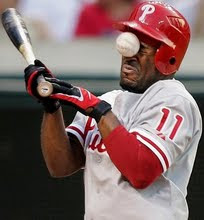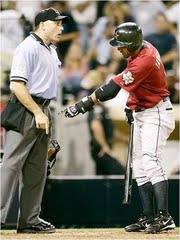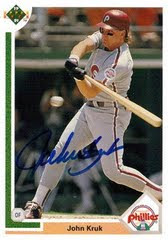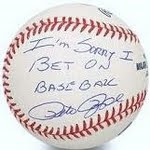The following is taken from my latest article for
The Hardball Times:
I have come to love the auction draft fantasy format. Tired of watching my targeted sleepers and studs go a few picks before my turn, sick of being entirely helpless and at the mercy of my fantasy provider's value rankings, I opted to work the free market in recent seasons.
The glory of auction is that every owner has a chance at every player. The auction format and bidding market equalize the stress of not having a top five pick in your league's snake draft, precluding you from one of the upper echelon elite players. Auction is not without its own stresses, however. The free market operates efficiently only when its participants are informed. Like the seller of an album of baseball cards who does not understand the value of a
1963 Topps Pete Rose card, an uninformed bidder is substantially less likely to profit on the open market.
Being informed requires more than knowing raw stats and having a player projection. Believing that
Jay Bruce will hit .280 next season with 30 home runs, five to 10 stolen bases, and 85 runs and RBI is nice, but unless you know the league average player output, Bruce's projection is meaningless. Player valuation requires some appreciation of relative category weights and scarcity. To deal with this issue and weight player values, I have a methodology, which I explain below. I have also included a pricing guide applying this methodology to Oliver's 2011 preseason player projections as of Feb. 1.
First, three points that will inevitably arise:
My methodology, like any pricing guide, has an inherent limitation: the quality of the projection system. My methodology weights relative stat production, but if the projections are weak, then the pricing guide will inevitably be weak. For the purpose of this article, I used Brian Cartwright's Oliver projection system from The Hardball Times to create a pricing guide. Oliver has proven to be a very reliable system, on par with ZiPS (not released in full yet) and CHONE (now defunct). You can access Oliver's statistical projections (and more) by subscribing to
THT Forecasts.
Second, for the purposes of simplification, I analyze all hitters as utility players. Some people like to adjust their numbers to account for position, but I'd rather just index the top 20 players by position after I have my Z-Score totals and know how much actual value, unbiased by position, each player is going to provide.
Third, there are better and more accurate methodologies out there. One is readily available via
THT Forecasts. Another system is one created by
Tom Tango a few years back. I know that Zach Sanders (of Fangraphs) and some others are working on something very similar as well. What I present to you today is merely what I do on my own, which I hardly proclaim to be unique. I am certain that someone out there probably uses, and invented before me, this same methodology to value players.
In honor of Steve Phillips,
who values baseball players with his eyes and heart, I have dubbed this system of dollar valuation the Expected Year's Evaluation Statistic, or E.Y.E.S. for short.
Step 1: Determining the size of the player pool
Determining the size of your expected active player pool (those players who will be on some player's team as either a starter or bench player) is essential because only a limited set of major league talent gets used in fantasy. This is true even of AL- and NL- only formats. Because not every player gets drafted, valuing players is a two-tiered process. First, you separate potential active roster talent from "the rest." Then, you evaluate the players in the pool. This will be explained in further detail below.
Before we can determine a potential player pool, we must determine an approximate depth for the pool. Let the number of teams in your league equal X. Let the total number of drafted hitters per team equal Y, and the total number of drafted pitchers per team equal Z. For the purposes of this analysis, I am going to use a 12-team league with one of each active infield position player (C, 1B, 2B, SS, 3B), one corner infielder (CI), one middle infielder (MI), five outfielders (OF), and one utility player (UTIL), for a total of 13 hitters per team. I am also going to use nine generic pitching slots. There is also the matter of the bench. I usually play in leagues with five bench spots, which will be spit three to two between hitters and pitchers. This gives us a grand total of 192 batters and 132 pitchers, for a total of 324 players.
Of course, the player pool is quite subjective and often much deeper than a consensus 324 players. In step 2, I deal with this problem, but 192 hitters and 132 pitchers will be our starting point.
Step 2: Calculating preliminary Z-Scores
A Z-Score sounds much more complex than it really is. Okay,
maybe not, but Excel (or Open Office) makes Z-Score calculations easy. Simply put, a Z-Score measures how many standard deviations from the mean (either positively or negatively) a given statistic is. For our purposes, players with high Z-Scores will help you in a given statistical category. Players with a Z-Score of 0 will have a neutral effect. Players with Z-Scores below 0 will hurt you in a category. The greater (or lower) a Z-Score, the more of an impact, for better or worse, a given player will have for your fantasy team in a calculated category.
To fill out a player pool, I first calculate the Z-Scores for every player for each of the hitting and pitching categories. For hitters, I use only a pool of players expected to accrue a minimum of 400 plate appearances. I am sure there are a few fantasy-valuable players out there who will come to the plate fewer than 400 times this season, but they are few, so I have ignored them for this demonstration. Per Oliver's 2011 projections, the pool of hitters who are expected to have 400-plus plate appearances is 436 players deep. Among these 436, the mean batting average is .265, the mean home run total is 14.0, the mean stolen base total is 8.1, the mean runs total is 62.6 and the mean RBI total is 61.0. The standard deviations for these respective categories are .019, 7.9, 7.8, 11.6 and 17.1.
To calculate any given category's Z-Score for a player, you simply take the difference of that player's stat against the mean for that stat and divide it by the standard deviation. For instance,
Albert Pujols is projected by Oliver to hit 43 home runs. To calculate Pujols' home run Z-Score (labeled Z-HR in my charts), we take the home run mean(14) and standard deviation (7.9) and use the following formula: (43-14)/7.9. If you plug that into your calculator, you will find that Pujols' Z-HR is 3.67.
Now do this for every player for every statistic, and when you are done, sum up each player's cumulative Z-Score. Then repeat this process for pitchers, using wins, saves, ERA, WHIP and strikeouts. I also like to use K/9 for the purposes of evaluating pitchers.
By now, you have probably wondered how I plan to value rate stats. A .300 hitter is not nearly as valuable as a .290 hitter if the .300 hitter is getting two-thirds the playing time of the .290 hitter. To deal with this problem, I determined the average at-bat total for all players expected to accrue 400 or more plate appearances (468.8) and I multiplied the batting average Z-Score by the player's actual at-bats total divided by the league average at-bats total. This adjusts the Z-Scores for batting average to reflect playing time. I do something similar with innings pitched for pitchers.
Step 3: Distillation
Once we have a series of player Z-Score sums for batters and pitchers, we need to select the "cream of the crop" to represent the potential player pool. If you recall above, we determined that, at least for our example, our league would use 324 active players (192 batters and 132 pitchers). Accordingly, I begin by selecting the 192 batters and 132 pitchers with the highest Z-Score sums. These players should represent our best "all-around players" for drafting.
This is not the end of step 3, however. Fantasy teams are dynamically comprised and owners often draft one or two category guys to fill holes and to stream. To account for this, I then rank the residual player pool by categorical Z-Score. I then pull out any player with a Z-Score of 1.0 or higher in any fantasy category. I also add any remaining players who I think are "interesting" to my player pool, even if their categorical Z-Score is less than 1.0, as $1 buys to keep an eye out for. Not even the best projection systems gets every player right, and this element of player selection requires personal judgment. For instance, Oliver is incredibly bearish on
Aaron Hill, who I like for 2011. His Z-Score sum is not within the top 192 and he does not have a Z-Score of 1.0 or greater in any single category. Nonetheless, I added him to my player pool.
Doing this, I ended up with 235 hitters and 166 pitchers, for a grand total of 401 players. This seems reasonable.
Step 4: Calculating primary Z-Scores
Now that we have our pool of 401 players, we need to recalculate our Z-Scores to reflect the draft pool talent. If you want remotely reliable numbers for draft day, it is pointless to value player X against undrafted players. These 401 player represent the best of the fantasy crop, and accordingly, the means and standard deviations in each category between them will change. Among the 235 hitters in our example sample, for instance, the mean batting average jumps up to .272 (from .265), the mean home run total jumps to 17.2 (from 14.0), the mean stolen base total jumps to 10.6 (from 8.1), the mean runs total changes to 70.4 (from 62.6), and the RBI total bumps up to 69.1 (from 61.0). The standard deviations also change to 0.018, 8.8, 9.3, and 18.0, respectively. The average expected at-bat total also rises from 468.8 to 497.2.
Re-calculating and re-summing each player's Z-Score, we are left with the expected relative value weights of each player.
Step 5: Calculating dollar values
Once we have relatively weighted Z-Score sums for each player, we now need to determine each player's dollar value.
To calculate dollar values, we must determine the total amount of money in our fictional economy. Simply put, we need to determine how much money exists to be split among the players with positive Z-Scores (all players who are ultimately assigned Z-Scores below $1 will have their dollar values rounded up to $1). Using the standard $260/team budget, applied to our 12-team fictional league, we find an economy with $3,120 in it. In real life, you could barely buy a pimped-out MacBook pro with that money, but here you can buy
CC Sabathia!. Alas, I digress.
Take this $3,120 total and divide it by the total Z-Score sum across all hitters and pitchers. The Z-Score sum from which to divide the economy value by should not include any players with negative Z-Scores; ignore these players for the sake of Z-Score valuation. Doing this will give you a rough dollar value estimate per Z-Score. Take this dollar value and then apply it to each player's Z-Score to get your estimated dollar value for that player.
Keep in mind that the minimum bid for any player is $1. Certain players in our draft pool, particularly the "one category" players (hitters or pitchers with a Z-Score of 1.0 or greater in only a single category), have Z-Scores below 1.0. Other players probably have Z-Scores that, when multiplied by our Z-Score dollar value, have Z-Scores under $1. Because these players will actually cost you at least $1, all players with dollar values under $1 are rounded to $1.
And there you have it. That is how you can calculate dollar values (EYES) for auction on your own. Use your EYES (not your heart) on draft day! Empower yourself with information. Of course, you could also do none of this analysis, save yourself some time, and purchase a subscription to the substantially more accurate
THT Forecasts, which has its own built-in pricing guide for Oliver. I guarantee you those numbers are much better than mine.



























